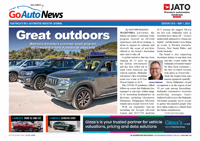Make / Model Search
News - Hyundai - ElantraHyundai heralds ElantraEuro-style: The Elantra body styling is more European than on previous Hyundais. Hyundai upgrades its medium-class car30 Aug 2000 By STEVE KEALY HYUNDAI's mid-sized car, the third-generation Lantra, goes on sale in October with a slight name change, becoming Elantra in line with most other countries. The name was original blocked by Mitsubishi retaining Elante for the Magna. Third time around, the range gains a five-door hatch, although a replacement for the Sportwagon is at least two years away. However, there are enough of the "old" wagons in Australia to last until the end of the year. The new Elantra four and five-door models are available in GL (97kW, 1800cc) and GLS (104kW, 2.0-litre) specifications with either a five-speed manual or four-speed auto. Both engines deliver 3kW more than their predecessors but with improved economy and reduced emissions. Body styling is more European than on previous Hyundais, with a distinctive front end. The nose has four separate lamps with black surrounds behind clear plastic covers there is a small, deep blacked-out grille and a much larger air-intake below the body-coloured bumper. The sedan's tail has large, modern "top corner" lamp clusters that light up with internal circles, much like the S-Type Jag, with a slightly raised rear deck and a thin crease on either edge which flows from the C-pillar to the bumper-high sill. The hatch is significantly different and offers a small lip-spoiler at the rearmost edge of the rear deck. Both are distinctively styled and go a long way to shaking off the bland image of some South Korean exports. According to Hyundai, the new Elantra is 75mm longer, 20mm wider, 32mm higher, 12 per cent more aerodynamic, 3kW more powerful, 5 per cent more fuel-efficient and 42kg heavier than the outgoing model. Setting its sights high, Hyundai benchmarked the Elantra against Mazda 626, Corolla, Audi A4, Pulsar and Vectra for interior space, noise, vibration and harshness (NVH), and performance. Specific changes over the old model include a driver's airbag, front belt pretensioners, re-tuned all-independent suspension, 15-inch wheels, gas dampers and fuzzy-logic adaptive auto-transmission control. Many other alterations to engine, drivetrain and chassis combine to give a more refined and purposeful feel. An optional Extra Safety pack offers a passenger airbag - and on sedans only, ABS - which requires a different rear axle complete with rear disc brakes, replacing the standard drums. DRIVE IMPRESSIONS: IN a test drive of pre-production cars in South Korea, Elantra proved to be smooth, quiet, comfortable, efficient, reasonably brisk and extremely easy to drive - all aspects which will appeal to potential Hyundai buyers. The GLS manual sedan was available and proved a good balance of driveability with more than adequate performance, light but well weighted steering, adequate brakes and well controlled suspension. Some complaint might be levelled at a vague clutch engagement or some wind noise from beneath the car at higher speeds, but since these were pre-production units it is very likely that mainstream cars will be better. Other drivers of auto and hatch models reported no significant vices either. The Elantra offered easy access to cabin and boot and adequate leg-room for the rear seat passengers, where three headrests and lap-sash belts are provided - but three full-sized passengers may find the rear seat a little too intimate for long periods. Controls are intuitively ergonomic and there is an abundance of storage bins, cupholders and oddments trays around the cabin. An optimum driving position is available to almost all size drivers, thanks to the adjustable steering column and a good range of seat adjustments, which includes lumbar support. There is very good space in the driver's foot-well, although some may complain that the lower right edge of the central console restricts knee-room. Manual drivers might also find they bang elbows on the central storage bin between the seats. Driver visibility is good and is well served by three well placed mirrors. Instrumentation is uncomplicated and clear with controls falling well to hand. The only downside to the interior continues to be the vast tracts of grey plastic on the dashboard. Prices are yet to be announced but both four and five-door cars in manual and automatic, GL and GLS trim levels will be available in October. |
Click to shareHyundai articlesResearch Hyundai Elantra pricingMotor industry news |









Facebook Twitter Instagram